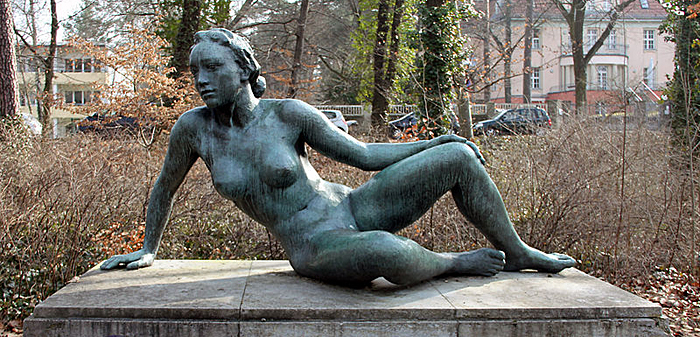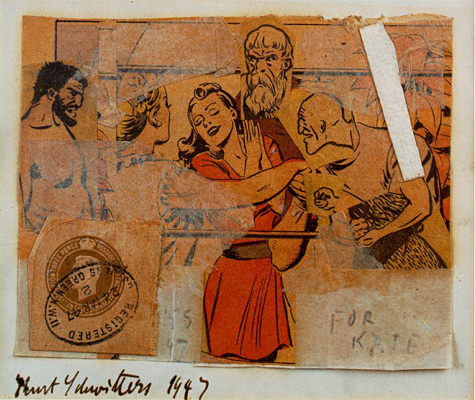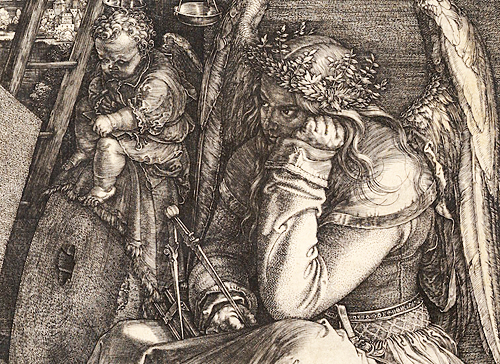Kurt loved to plan projects; even if a project did not come to fruition, the entire process of planning it fascinated him. One such project was a “Pyramid Project” involving the research and coordination of constructing a 45-foot wide pyramid on the campus of Sacramento State University. An interesting discussion between Kurt, university colleague Ken Switras and others involved in the project was recorded and transcribed during the planning process in 1979; a portion of that transcript is presented here. Kurt had already found the subject of pyramids of interest, and exploring his interest within an academic setting suited him just fine.
Stars and Galaxies
This chapter from Kurt’s 350,000-word masterwork A Ball of Twine illustrates the range and depth of his knowledge, interests and humor. His analysis of Duchamp’s sculpture With Hidden Noise proceeds in a systematic yet constantly surprising way, in keeping with Kurt’s talents as a teacher and polymath. “What we can perceive, measure, and record of such micro- and macrocosmic events must be integrated into human consciousness no less so (but neither with any greater imperative) than our perceptions of theater, music, flower arranging, or any of the other arts. Any one of these "soft" activities undertaken by an accomplished practitioner may illustrate--in the end, with the same order of legitimacy as for any of the "hard" sciences--those underlying laws governing all formal interactions and thus determining (besides helping us to describe or explain) why things are the way they are.”
A K von Meier Mind Map
A unique find among Kurt’s archives was a very large sheet of paper, folded into 16ths like a map, entitled TWINE. In keeping with his interest in Marcel Duchamp, upon this sheet Kurt mapped a series of links and associations tied to Duchamp and a number of his most notable works of art. This combination of abbreviations, authors’ names, books, art history, and cultural references — in addition to providing a thread pertaining to Duchamp — also provides a view into Kurt’s mind, and his map-like way of seeing connections and organizing his thinking. Enlarged sections of this “map” are provided on the following page.
Jewel, Joke and Juggernaut
Here is another selection from Kurt’s magnum opus “A Ball of Twine”.
“The merchants, as a class in traditional China, were typically ranked at the bottom of the social ladder: middle men, schleppers, people who performed a derivative function, something that does NOT belong to a primary order of reality. For, although the Great Spirit is One and abides in all things, and in the dance that all things do, ordinary human beings come to know It best through primary expressions of art (including architecture, music, poetry, calligraphy, theater), through plants (from gathering to farm and garden), through animals (from the primordial rite of hunting to the companionship of pets), and through the regenerative mystery of a baby newly-born. Aesthetics relates to the ways in which we structure material stuff to articulate the spaces and durations, recreating expressions of the Great Spirit: naturally emanating from orders of aware consciousness. Money--unless it is a beautiful coin by Pisanello or a Check by Duchamp--does not.”
The Artists of New Zealand - 1963
Kurt’s time teaching in at the Elam School of Fine Arts in New Zealand was a mixed experience. On the one hand he enjoyed a measure of celebrity as an American art historian, but on the other, New Zealand’s cultural scene in the early 1960s was not terribly appealing. In this lengthy article, he writes, “New Zealanders prefer to import most of their cultural pretensions tinned or pickled, ready to serve, and the feast on a season's fare courts an aesthetic ulcer annihilating all future appetite...the popular level of aesthetic taste ascends to the heights reached by Sunday school pictures or gazelles sand-blasted in the front door glass.”
Nonetheless, Kurt established relationships with the island’s young, upcoming artists (and today, accomplished), and found plenty to enjoy: “In contrast to this, however, are the bright prospects of a new movement in the fine arts. Its youth and impertinence both serve as motivating forces and protective devices.” An opportunity to hone his skills in writing art criticism, this essay presages his later work for Art International and Artforum magazines.
UCLA Lecture 1967 - Renaissance to the Present
A 1967 lecture that begins as a very straightforward art history lecture about the Renaissance turns to Kurt’s concerns about teaching art history itself, and reflects upon the crisis in his own teaching career. His UCLA teaching contract terminated due to his controversial and unconventional teaching style and views about education, he reflects upon his aspirations as a teacher and intellectual. Remarking on the absurdity of it all for his students, he says, “But you do become absurd. You lose your sense of joy and discovery, humanity, you act and respond like machines. I know you do. I know because I know these forces on my life too, essentially the same forces.” And, facing the career crisis in his own life, he remarks, “Every time we reach that ultimate point in states of consciousness, we're in a critical situation; we can choose. Crisis, crossroads; take your choice which way you gonna go? Forward, backwards, left or right. Crisis mean crux, cross, crosswalks, crucial; every time you can choose you're free. Every time you do choose, you affirm your freedom. Every time you affirm your freedom, you affirm life.” Both informative and revealing, this lecture is available as both audio file and transcript.
HUMANISM
In this excerpt from his monumental and masterful work A Ball of Twine: Marcel Duchamp's 'With Hidden Noise' Kurt von Meier examines humanism, its transformation into "individualistic humanism" and as an art historian provides an honest account of humanity's often dismal history. He writes, "The history of catastrophes is not often taught. Nevertheless, an objective account of destruction ought to be contemplated by serious educators, busy extolling themselves for the imagined accomplishments of their self-titled humanistic research. It would serve as a darkly instructive reminder about the flip side of pride. Otherwise, there seems to be self-deception in writing about art and culture without, from time to time, stopping to take stock of humanity at large, in the conventional real world...If there is sometimes a Polyanna complex on the part of scholars who write as though they have just come from, say, the planet of lost art historians, as Howard Zinn reminds us the newspapers and many of the grimmer historians also ignore the history of creativity and kindness."
Popular and Fine Arts - A UCLA Lecture 1965
In this class-note transcript from 1965, Kurt delivers a straightforward art history discussion of an essential shift in 20th century painting: the rise of Cubism and its meaning. "Before Cubism, there had always been one point of view. This is specifically manifested by the theory of one point perspective formulated in the Italian Renaissance. This perception from one point of view was prevalent all the way through the 19th century," he states. His lectures would become less traditional and more theatrical as time went on; this lecture is "all business."
The Secret Ball of Twine: A Lecture from 1986
Though no printed copy of this lecture appears in Kurt's archives, a tape recording does exist, and now transcribed in written form, accompanies the digitized recording. This guest lecture was delivered at UC Davis in 1986 during the presentation of a replica of Duchamp's sculpture With Hidden Noise that had been created by UC Davis graduate student Tamara Blanken.
Of particular note here is Kurt's analysis of the secret object within the sculpture, and conjecture as to its nature. His "by the numbers" approach was used in his 1991, 350,000-word magnum opus in which he concludes the hidden object that makes the "hidden noise" is a six-sided die, such as used in playing craps. He does not disclose that conclusion in this lecture, but he does hint at it several times. Unusually, Kurt reads his lecture, rather than simply speaking extemporaneously, and at times sounds like he's hurrying; the tape (and transcript) ends before he did, unfortunately.
Kurt would appreciate, perhaps, that this lecture transcript was created via speech recognition software, and subsequently was corrected for accuracy by a human being.
A Survey of Mozarabic Manuscript Illumination
In this paper prepared by for Professor Dr. K. Weitzmann of Princeton University in 1960, Kurt's command of art history and ability to write cogently on a subject is already quite evident. Kurt had previously spent a year at the University of Madrid while pursuing his undergraduate degree, which undoubtedly added to his interest in the subject of Mozarabic illumination. This is one of the shorter papers Kurt retained from his Princeton years; others, such as an analysis of Chinese scroll paintings were many times longer. His command of language--not only English--and the benefits of a classical education, combined with his extraordinary memory, made Kurt von Meier an exceptional student.
Preparatory Notes: Occidental Art and Mythology
As a teacher, Kurt was always preparing for his lectures, keeping notes and developing topics and themes for presentation.
In this set of class preparation notes for Occidental Art and Mythology in 1979, we find Kurt pulling from his deep education in art and culture as well as from news articles in the San Francisco Chronicle. It's unlikely that these notes were for just one lecture, but it's possible. His madness was his method; he lays it out this way: "...the stage show, slides in class, acting-micro theater within theater, demonstrations within the theater as they belong to the algebra or application through variables while in the theater of teaching, where something is shown as in the Elusinian Epoptea."
On Audio: Horseshit vs. Bullshit - An Art History Lecture, 1968
Comparing horseshit with bullshit is how Kurt begins this Art History lecture, recorded sometime around 1968. He is at his entertaining, informative best--funny, insightful, challenging and relevant to the times. Reflecting on so-called "primitive culture", Kurt calls into question many of our civilized values, quoting anthropologist Claude Levi Strauss in the process and invoking the likes of Buckminster Fuller, Carlos Castaneda and Marshall McLuhan. Using examples from his collection of Navajo blankets (example above), he vividly connects the psychedelic revolution with the ancient peyote rituals of Pueblo Culture, and warns of the ways civilization is destroying the earth.
Death of the Masterpiece
Here's a short, hand-written essay by Kurt which appears to have been drafted while in attendance at or not long after his graduation from Princeton University. As such, it's as an early gesture in his direction of art criticism, an activity which would occupy his talents as an art historian in various publications for the rest of the decade. His theme anticipates the thrust of his later, more sophisticated, articles-- he writes, "...in approaching the 20th century, it becomes increasingly difficult to single out works of art as “masterpieces”...New standards of selection should be introduced which enable us to consider the complete oeuvre of a painter as an entity." No typewritten version of this essay has been found in his archives.
Georg Kolbe - Kurt's Doctoral Dissertation
Kurt submitted his doctoral dissertation on the German sculptor Georg Kolbe (1877-1947) to the Department of Art and Archaeology at Princeton University in 1965. Combined, the text, notes and illustrations numbered over 800 pages, far too much to upload to this website. However, the Introduction has been scanned and converted to digital text (and a few images added) so that it can be included with the rest of Kurt's archives.
Chance in Music and the Visual Arts: A UCLA Lecture 1966
Here is another of Kurt's art history 1C lectures at UCLA from 1966. At this point in his career, Kurt was sticking fairly close to a traditional teaching approach in this class, using slides and discussing the work of various artists. However, his focus on the use of chance in art bespeaks his fascination with that topic, which would be life-long. For those of you who wish to gain some background into the who, what and when of art history, it's informative.
Games and Chance: A Lecture
In this transcript of a lecture given by Kurt at UCLA in 1966, a number of subjects and themes emerge which continued to play a dominant role in the successive years of his teaching and personal life, namely the role of chance in art, the use and meaning of Tarot cards, and the work of Marcel Duchamp. On chance, Kurt notes, "Chance also became material for the artist, but this was not until the 20th century. This area becomes an important confluence of science, mathematics, and art." And on the Tarot: "We are dealing with human experience, and as historians of culture, we must be very careful not to exclude relevant material . We should find an interest in it in order to reach a better understanding of the specific works of art that would be difficult to explain fully or even understand superficially without such knowledge." Kurt was a superb art historian; his students at UCLA were very lucky.
Modern Times
The topic of modernity takes center stage in this short essay penned in 1967 by Kurt, a reflection upon the shift from an industrial notion of modernity, a la Charlie Chaplin, to an electronic one, a la Marshall McLuhan. Our view of history, Kurt notes, also has changed. "The recent past, approximately the last 500 years, has provided us with the conceptual and methodological equipment with which to resuscitate the distant past before it." And as an art historian, Kurt explores modern media and media figures, including comedians. "There are no more Chaplins. Modern times are now too complex, at once too gross and too subtle, to be counted out in the coin of such comedy."
The Revolution of Popular Art
This article from 1968 was published in the pages of artscanada, a magazine in which Kurt frequently appeared. He explores the events and figures leading up to what he terms a "revolution of Popular art" wherein past distinctions, categories and criticism no longer apply. "A more finely-focused view discovers that neither is there any longer a precise sense of differentiation between the various "media" within the realm of fine arts. Nor, in terms of a much more general view, have the clear-cut separations between art and life been able to function with quite the same surety as they did, say, before the beginning of the century."
Utilizing Esoteric Traditions of Knowledge
In this paper, clearly intended for presentation as a lecture, Kurt makes his case that art history demands the incorporation of the knowledge of esoteric traditions. Using Michelangelo's Sistine Chapel frescoes as his jumping off point, and by identifying the figures and symbols Michelangelo incorporated into his work, Kurt is able to navigate towards early Greek influences and derivations. He writes, "A recurrent theme in much of my teaching and research is the notion of renavatio or Renaissance, not exclusively in the technical sense of art historians, but rather as the principle of rebirth or renewal, distinguished function of ours own psyche, and a fundamental, indeed, necessary experience for the human spirit."
Artistic Melancholy
Kurt's lectures at UCLA began as rather traditional ones in 1966. This lecture delivered in his class Art 1C traces the incorporation of temperament within art history. His concerns with non-traditional forms are, nonetheless evident. "It is the misunderstandings in the history of anything in the humanities that is as interesting, if not more interesting, than something that has been understood correctly," he states, and later, "To ignore astrology would be to do so at the peril of our history, for we are involved in all the humanities. It involves human beings, and we have an intellectual obligation to question and be skeptical about everything human beings believe in."






































